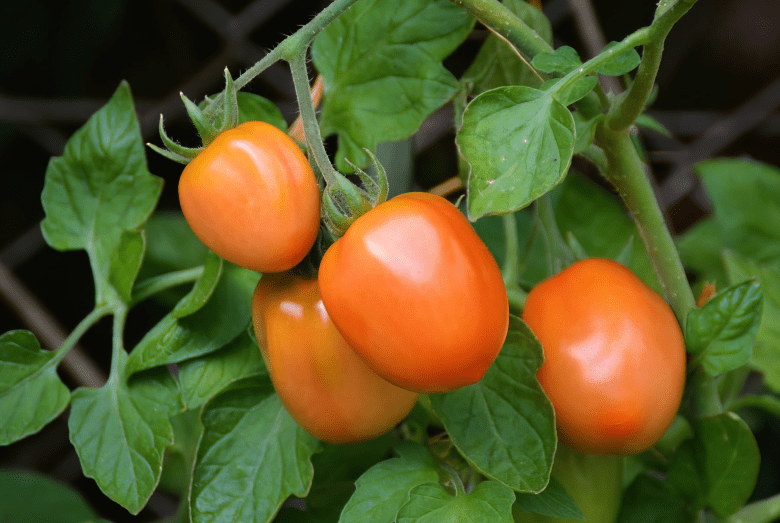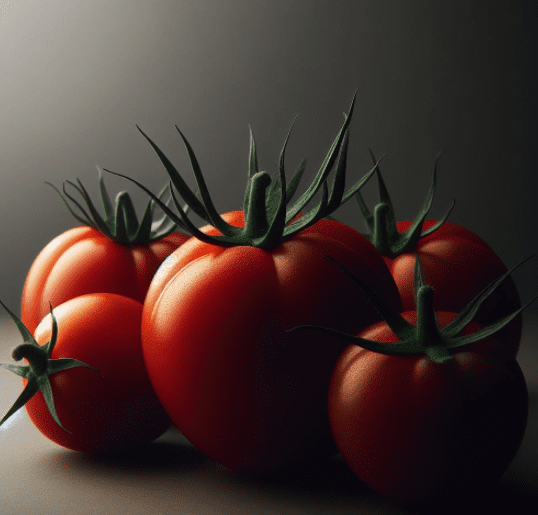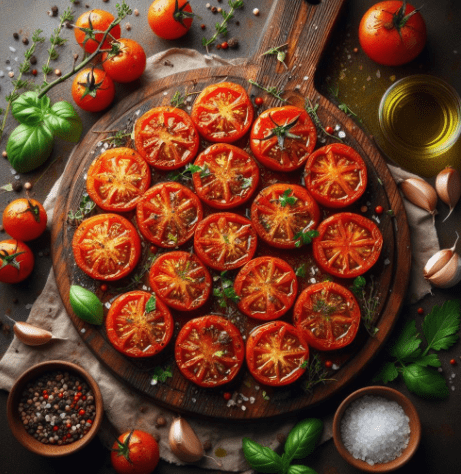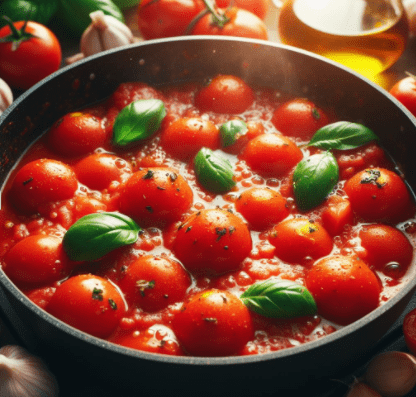
Roma tomatoes, renowned for their robust flavor and meaty texture, are a kitchen staple. This versatile variety shines whether you’re making homemade marinara or a fresh Caprese salad. But did you know there are secrets to growing the most flavorful, abundant Roma tomatoes? In this guide, we’ll cover everything you need for a bumper crop, plus tasty ways to use your harvest!
Roma Tomatoes
- Common Name: Roma tomato
- Botanical Name: Solanum lycopersicum
- Plant Type: Annual (treated as a perennial in very warm climates)
- Determinate or Indeterminate? Roma tomatoes are determinate, meaning they grow to a set size and then focus their energy on producing fruit.
- Growth Habit: Bushy but can become quite large
- Uses: Sauces, pastes, canning, fresh eating

Planting Your Roma Tomatoes
- Timing: Plant after the last frost. Roma tomatoes are sensitive to cold.
- Site Selection: Full sun (at least 6-8 hours), well-drained soil rich in organic matter.
- Spacing: 24-36 inches apart.
- Planting: Plant deeply, burying much of the stem for stronger root development. Provide support (cages or stakes) at planting time.
- Hardening Off: If starting seeds indoors, gradually acclimate them to outdoor conditions.
Caring for Your Roma Tomatoes
- Watering: Water deeply and consistently, especially during fruiting. Aim for 1-2 inches of water per week. Mulch helps retain moisture.
- Fertilizing: Feed with a balanced fertilizer every few weeks during the growing season.
- Pruning: Regularly remove suckers (small shoots at branch joints) for better airflow and fruit size.
- Support: Cages or sturdy stakes are essential to prevent sprawling and fruit rot.

Common Roma Tomato Problems
- Blossom End Rot: Caused by calcium deficiency. Prevent with consistent watering and soil amendments.
- Blight: Fungal diseases often occur in humid conditions. Ensure good air circulation and remove affected leaves immediately.
- Pests: Aphids, tomato hornworms, etc., can be managed with insecticidal soap or handpicking.

Harvesting and Using Your Roma Tomatoes
- When to Harvest: Romas are ripe when deep red and slightly firm. They should come off the vine easily.
- How Many Romas in a Pound? Approximately 3-4 medium Roma tomatoes per pound.
- Storage: Ripe Romas stay on the counter or longer in the fridge for a few days. They’re perfect for canning and freezing.
- How to Dice/Cut Roma Tomatoes: [Include a short section with photos or a quick video demonstration]
Delicious Roma Tomato Recipes
Classic Roasted Roma Tomatoes

-
Ingredients:
- 2 pounds Roma tomatoes, halved lengthwise
- 3 tablespoons olive oil
- 1 teaspoon dried Italian herbs
- 1/2 teaspoon salt
- 1/4 teaspoon black pepper
- 2 tablespoons balsamic vinegar (optional)
-
Instructions:
- Preheat oven to 400°F (200°C).
- Toss tomatoes, olive oil, herbs, salt, and pepper in a bowl.
- Spread on a baking sheet in a single layer.
- Roast for 30-40 minutes, or until tender and slightly browned.
- Drizzle with balsamic vinegar (if using) and serve warm or at room temperature.
Simple Homemade Tomato Sauce

-
Ingredients:
- 3 pounds Roma tomatoes, coarsely chopped
- 1/4 cup olive oil
- 1 medium onion, chopped
- 4 cloves garlic, minced
- 1 teaspoon dried oregano
- 1/2 teaspoon dried basil
- Salt and pepper to taste
- Fresh basil leaves for garnish (optional)
-
Instructions:
- Heat olive oil in a large pot over medium heat.
- Add onion and cook until softened, about 5 minutes.
- Add garlic and cook for 1 minute more.
- Stir in tomatoes, oregano, basil, salt, and pepper.
- Bring to a simmer, then reduce heat and simmer for 30-45 minutes, or until thickened.
- Taste and adjust seasonings. Use an immersion blender for a smoother sauce, if desired.
- Serve over pasta, or use for pizza or lasagna.
Fresh Roma Tomato Salsa

-
Ingredients:
- 1 pound Roma tomatoes, seeded and diced
- 1/2 cup chopped red onion
- 1/4 cup chopped cilantro
- 1 jalapeño pepper, seeded and minced (optional)
- 2 tablespoons lime juice
- 1/2 teaspoon salt
-
Instructions:
- Combine all ingredients in a bowl.
- Adjust seasonings to taste.
- Let sit for at least 30 minutes for flavors to meld before serving with tortilla chips.
Other Ideas: Salsa, salads, sun-dried tomatoes, and more!
-
Salsa variations: Go beyond the classic recipe with additions like:
- Roasted Corn Salsa: Adds a smoky sweetness.
- Mango Salsa: A tropical twist with fresh mango and cilantro.
- Black Bean and Corn Salsa: Hearty and packed with protein.
- Salads beyond Caprese: While delicious, there’s more to do with Romas! Try:
- Panzanella Salad: A Tuscan bread salad with juicy Romas, crusty bread, and a tangy vinaigrette.
- Greek Salad: Romas pair perfectly with cucumbers, Kalamata olives, and feta cheese.
- Pasta Salad: Toss diced Romas into pasta salad with fresh herbs and a light dressing.
-
Sun-dried Tomatoes: Roma tomatoes are ideal for this! You have options:
- Oven Method: Slow-roast them for intense, concentrated flavor.
Oven-Dried Roma Tomatoes
Yields: Varies depending on the size of your tomatoes. Prep Time: 15 minutes Cook Time: 4-6 hours
Ingredients:
- 3-4 pounds Roma tomatoes, halved lengthwise
- 2 tablespoons olive oil
- 1 teaspoon dried Italian herbs (or your favorite blend)
- 1/2 teaspoon salt
- 1/4 teaspoon black pepper
- Optional: 1-2 cloves garlic, thinly sliced
Instructions:
- Preheat Oven: Preheat your oven to its lowest setting, ideally around 200°F (95°C). If your oven doesn’t go this low, 225°F (110°C) can work, but watch closely to prevent scorching.
- Prepare Tomatoes: Halve Roma tomatoes lengthwise and scoop out the seeds using a spoon or your fingers. This helps them dry faster.
- Season: Arrange tomatoes cut-side up on a baking sheet lined with parchment paper. Drizzle with olive oil, sprinkle with herbs, salt, pepper, and garlic (if using).
- Slow Roast: Roast tomatoes for 4-6 hours, or until they are shriveled, deeply colored, and slightly pliable, but not crispy. Check periodically and rotate the pan for even drying.
- Storage: Cool completely. Store in an airtight container with a layer of olive oil to cover. They’ll keep in the fridge for up to a week, or freeze for long-term storage.
Tips:
- Tomato Selection: Use the ripest, freshest Romas for the best flavor.
- Slicing: Cut tomatoes uniformly for even drying.
- Temperature Control: The key is low and slow. Higher temperatures will cook the tomatoes instead of drying them.
- Don’t Overcrowd: Leave space between tomatoes for air circulation.
- Uses: Add oven-dried tomatoes to salads, pasta, omelets, pizza, or enjoy them as a snack.
Dehydrator: Follow your dehydrator’s instructions for perfectly dried tomatoes.
Sun-drying (if climate permits): The traditional way takes time, but the flavor is incredible.
-
The Process:
- Roma tomatoes are halved (and seeds removed for faster drying), then salted lightly to draw out moisture
- They’re placed cut-side up on raised screens to allow for maximum airflow.
- Tomatoes are left in direct sunlight for several days, covered at night to protect from moisture.
- They’re ready when deeply shriveled with a leathery texture, but still slightly pliable.
-
Climate Considerations:
- Hot, dry weather is crucial. High humidity can lead to mold growth.
- Daytime temperatures consistently above 85°F (30°C) are best.
- Securely cover tomatoes overnight or if rain is expected.
-
Safety Note: Sun-drying requires careful attention to prevent foodborne illness. If temperatures are too low or conditions too humid, harmful bacteria can grow. If unsure about the safety of your climate or process, opt for oven or dehydrator drying.
-
The Flavor Advantage: Sun-dried tomatoes have a uniquely intense, concentrated sweetness and tang that’s hard to replicate with other methods.
Additional Notes:
- Salt: Some traditional recipes encourage salting before drying, thought to aid preservation and enhance flavor.
- Storage: Pack sun-dried tomatoes in olive oil and store in the refrigerator like oven-dried versions.
Beyond Fresh and Sauced:
-
- Tomato Soup: Romas make a rich and flavorful base for various tomato soup styles.
- Stuffed Tomatoes: Hollowed Romas can be stuffed with rice, herbs, and cheese for a hearty vegetarian dish.
- Tomato Jam: A sweet-and-savory condiment perfect for spreading on sandwiches or pairing with cheese.
Additional Notes
Preservation: Your Harvest All Year Long
Homegrown Romas are far too delicious to enjoy for only a short season! Here’s why they’re perfect for preserving:
-
Canning Sauces: The classic way to savor the summery flavor of Romas long after the season ends. Making your own sauce lets you control the ingredients and customize the taste.
-
Freezing: The easiest method for those short on time or new to preservation. Freeze whole Romas, chopped pieces, or even pre-made sauce.
Tips for Preservation Success
- Choose the Best: Pick Romas at the peak of ripeness, free from blemishes or soft spots, for optimal flavor and texture when preserved.
- Work in Batches: If you have a large harvest, don’t try to can or freeze it all at once. Smaller batches ensure quality and safety.
- Follow Safe Practices: Adhere to recommended canning or freezing guidelines for food safety. Resources from the National Center for Home Food Preservation (https://nchfp.uga.edu/) are a great starting point.
Quick Freeze
- Wash and dry Romas.
- Spread in a single layer on a baking sheet and freeze until solid.
- Transfer frozen tomatoes to freezer-safe bags for convenient, portioned use in sauces, soups, etc.
Additional Tips for the Best Roma Tomatoes
- Experiment with varieties: There are many types of Roma tomatoes, each with subtle flavor differences.
- Companion Planting: Basil and marigolds make great tomato companions.
Conclusion
Growing your own Roma tomatoes is a gratifying experience. Not only will you enjoy a harvest of intensely flavorful, versatile fruits, but you’ll also gain a deeper appreciation for the care and process that goes into the food we eat.
Whether you’re a seasoned gardener or a curious beginner, this guide has provided you with the tools to have amazing success with Roma tomatoes. So go forth, plant, nurture, and savor the bounty of your own tomato patch!


























